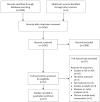The influence of growth hormone on pediatric body composition: A systematic review
- PMID: 36843617
- PMCID: PMC9947344
- DOI: 10.3389/fendo.2023.1093691
The influence of growth hormone on pediatric body composition: A systematic review
Abstract
Background: Growth hormone (GH) affects metabolism and regulates growth in childhood. The most prominent feature of GH deficiency (GHD) in children is diminished height velocity that eventually leads to short stature. In adult-onset GHD, lean body mass (LBM) is reduced, and visceral fat mass (FM) increased. Beneficial effects of GH treatment on body composition in adults with GHD, including an increase in muscle mass and a decrease in FM, are well established. Relatively few studies have investigated the effects of GH treatment on the body composition of pediatric patients with idiopathic or hypothalamic-pituitary disease-associated GH deficiency. This systematic review aimed to summarize available evidence relating to the effects of GH treatment on body composition in children with GHD.
Methods: The PubMed, Science Direct, Cochrane Trials, and Embase databases, were searched with keywords including "GH", "body composition", "children", and "growth hormone" for English-language articles, published between January 1999 and March 2021. Two reviewers independently evaluated the search results and identified studies for inclusion based on the following criteria: participants had a confirmed diagnosis of GHD (as defined in each study); participants were pediatric patients who were receiving GH or had stopped GH treatment, regardless of whether they were pre- or post-pubertal; the intervention was recombinant human GH (rhGH; somatropin); and outcomes included changes in body composition during or after stopping GH therapy. Data extracted from each study included study quality, study sample characteristics, study interventions, and body composition. Data on fat-free mass and LBM were combined into a single category of LBM.
Results: Sixteen studies reporting changes in body composition (i.e., FM and LBM) associated with GH treatment in children with GHD were identified and included in the review. Collectively, these studies demonstrated that FM decreased, and LBM increased in response to GH replacement therapy.
Conclusion: Despite study limitations (i.e., potential effects of diet and physical activity were not considered), we concluded that a periodic body composition assessment is required to ensure that a satisfactory body composition is achieved during GH replacement therapy in children with GHD.
Keywords: body composition; fat mass; growth hormone; growth hormone deficiency; lean body mass.
Copyright © 2023 Ferruzzi, Vrech, Pietrobelli, Cavarzere, Zerman, Guzzo, Flodmark, Piacentini and Antoniazzi.
Conflict of interest statement
The authors declare that the research was conducted in the absence of any commercial or financial relationships that could be construed as a potential conflict of interest.
Figures






Similar articles
-
AMERICAN ASSOCIATION OF CLINICAL ENDOCRINOLOGISTS AND AMERICAN COLLEGE OF ENDOCRINOLOGY GUIDELINES FOR MANAGEMENT OF GROWTH HORMONE DEFICIENCY IN ADULTS AND PATIENTS TRANSITIONING FROM PEDIATRIC TO ADULT CARE.Endocr Pract. 2019 Nov;25(11):1191-1232. doi: 10.4158/GL-2019-0405. Endocr Pract. 2019. PMID: 31760824
-
Adults with partial growth hormone deficiency have an adverse body composition.J Clin Endocrinol Metab. 2004 Apr;89(4):1586-91. doi: 10.1210/jc.2003-030761. J Clin Endocrinol Metab. 2004. PMID: 15070916
-
Serum leptin and body composition in children with familial GH deficiency (GHD) due to a mutation in the growth hormone-releasing hormone (GHRH) receptor.Clin Endocrinol (Oxf). 1999 Nov;51(5):559-64. doi: 10.1046/j.1365-2265.1999.00837.x. Clin Endocrinol (Oxf). 1999. PMID: 10594516
-
The consequences of growth hormone deficiency in adulthood, and the effects of growth hormone replacement.Schweiz Med Wochenschr. 1997 Aug 30;127(35):1440-9. Schweiz Med Wochenschr. 1997. PMID: 9297747 Review.
-
Growth hormone therapy in adults with growth hormone deficiency: a critical assessment of the literature.Pituitary. 2020 Jun;23(3):294-306. doi: 10.1007/s11102-020-01031-5. Pituitary. 2020. PMID: 32060708 Review.
Cited by
-
Biological effects of recombinant human growth hormone therapy on metabolism in children with growth hormone deficiency: a review.J Pediatr Endocrinol Metab. 2025 May 6;38(8):796-806. doi: 10.1515/jpem-2025-0057. Print 2025 Aug 26. J Pediatr Endocrinol Metab. 2025. PMID: 40320660 Review.
-
Pasireotide Exerts Anti-Inflammatory Effects in the Endothelium.J Biochem Mol Toxicol. 2025 May;39(5):e70306. doi: 10.1002/jbt.70306. J Biochem Mol Toxicol. 2025. PMID: 40358969
-
Carotid Intima-Media Thickness and Cardiometabolic Profile in Turner Syndrome: A Cross-Sectional Study.Cureus. 2024 May 31;16(5):e61439. doi: 10.7759/cureus.61439. eCollection 2024 May. Cureus. 2024. PMID: 38947673 Free PMC article.
-
Research progress in abnormal carbohydrate, lipid, and protein metabolism in children with isolated growth hormone deficiency.Front Endocrinol (Lausanne). 2025 May 22;16:1553008. doi: 10.3389/fendo.2025.1553008. eCollection 2025. Front Endocrinol (Lausanne). 2025. PMID: 40475996 Free PMC article. Review.
-
Clinical Management of Postoperative Growth Hormone Deficiency in Hypothalamic-Pituitary Tumors.J Clin Med. 2024 Jul 24;13(15):4307. doi: 10.3390/jcm13154307. J Clin Med. 2024. PMID: 39124574 Free PMC article. Review.
References
Publication types
MeSH terms
Substances
LinkOut - more resources
Full Text Sources

